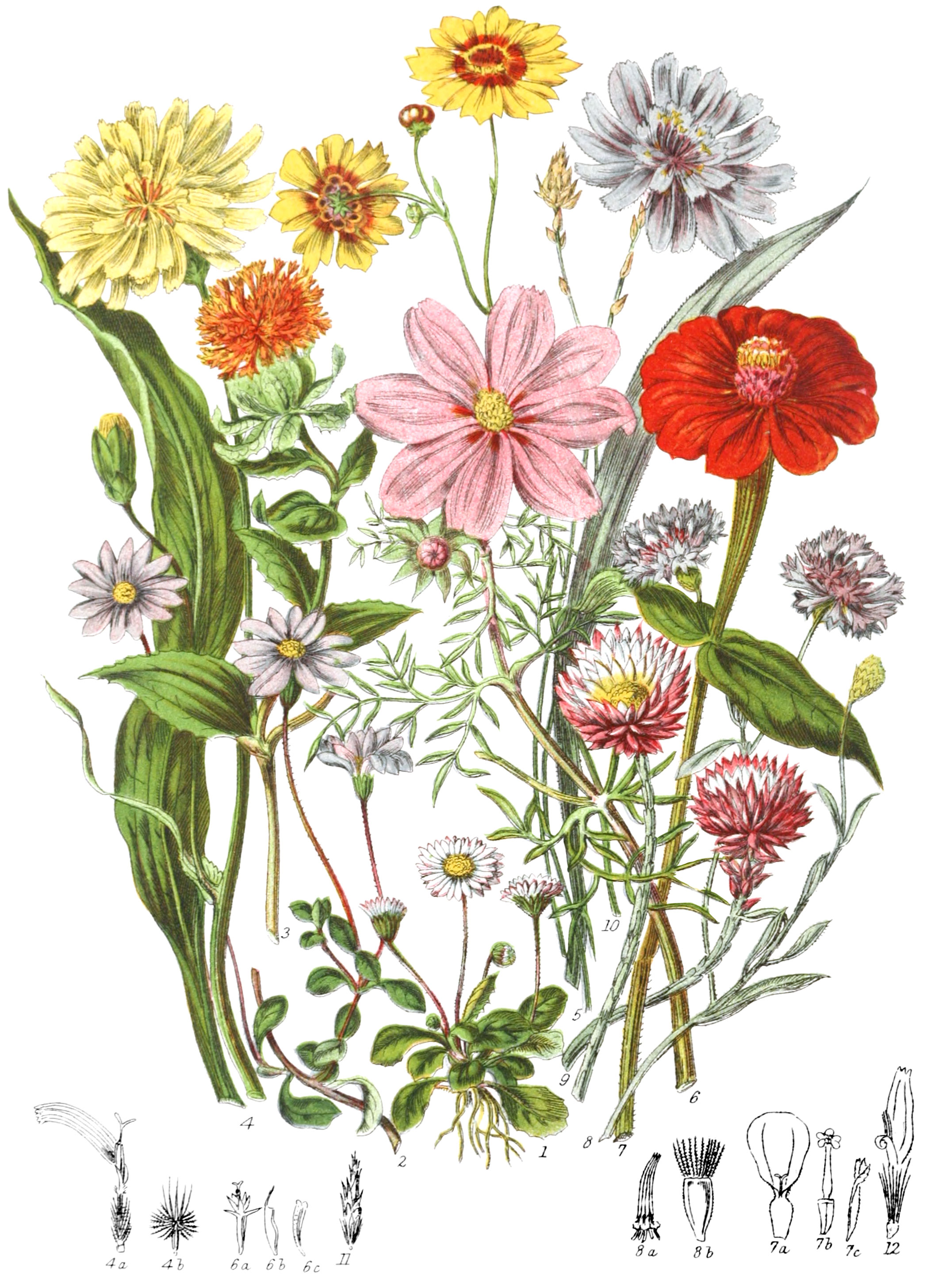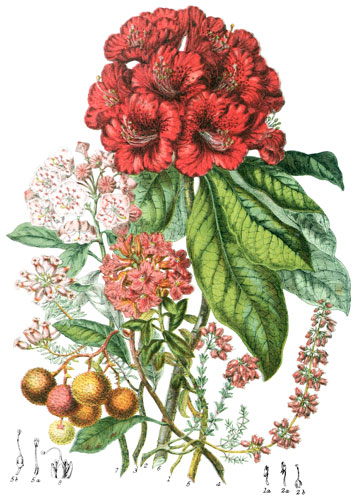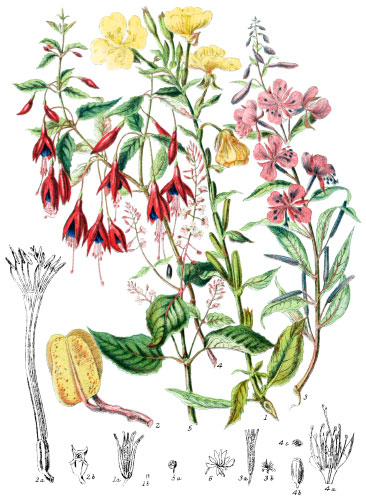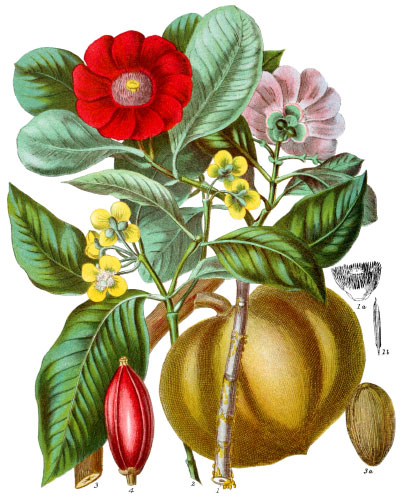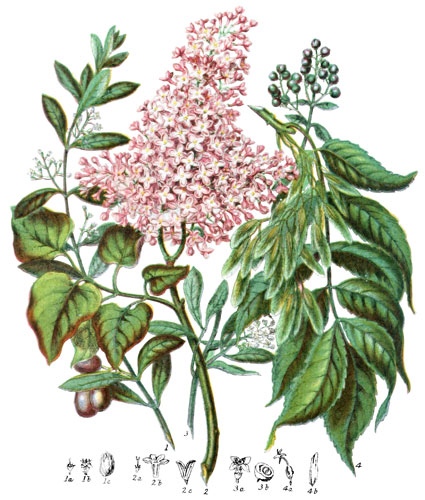Key characteristics
Herbaceous plants, shrubs, and trees. The leaves are alternate or opposite, without stipules, usually simple but generally much divided. The flowers are collected in close heads on a common receptacle, surrounded by an involucre. Bracts are sometimes present in the form of scales on the receptacle. The calyx is above the ovary, and closely united to it. The upper portion either wanting or membranous, divided into bristles, hairs, or feathery down. The corolla is of one petal, either funnel or strap-shaped, four or five-toothed at the top, sometimes bilabiate (12). The stamens are equal in number to the teeth of the corolla, and alternate with them; the filaments are jointed. The anthers cohere in a cylinder. The ovary is one-celled, with a single ovule; the style is simple, the stigmas two, downy or bristly. The seed-vessel is small, closed, dry, crowned with the top of the calyx; the seed is solitary, erect, with no albumen.
This order has affinity with Dipsaceæ, Campanulaceæ, and Lobeliaceæ.
Acrid, tonic, aromatic, and stimulating properties exist in these plants; some contain oil.
Select plants in this order
Not all plants listed are illustrated and not all plants illustrated are listed.
- This is one of the most distinctly marked of the Natural Orders, more extensively known now than was the whole vegetable world to Linnæus; comprising upwards of 1000 genera, consisting about 1-10th of all described species, affording numerous plants of great utility either as food or medicine, and contributing largely to the embellishment of nature, from the lowly Daisy (1) to the richly-coloured Dahlia.
- The prevailing colour of the commonder flowers, as of Dandelion, is yellow, but the finer species include every hue in great brilliancy.
- Among the plants yielding food, Scorzonera (4) has a slender white eatable root, of so mild a nature that it is probable the idea of its curing the bite of a viper is erroneous.
- Helianthus tuberosus is the Girasole, or Jerusalem artichoke, Cynara Scolymus, the artichoke introduced to English gardens from the south of Europe more than three centuries ago; like others of this class, it can endure much drought, and in the extremely hot and dry summer of 1825, in France, it was almost the only vegetable that survived to supply the markets of Paris.
- Cichorium was described by Pliny, who knew that the Egyptians made it an important article of food, as they do at the present time; the Greeks received it from Egypt, and adopted the same use of it.
- C. Intybus, Succory or Chicory, is frequent on the borders of our fields: the variety with larger roots is of more extensive use, they being dried and made into coffee.
- C. endivia, Endive, imported from the East Indies in 1548, is a common ingredient in salads.
- Lactuca sativa is the wholesome Lettuce, and a narcotic drug is obtained from it.
- The leaves of Helminthia echioides are boiled and pickled in Greece.
- Of the medicinal class, Artemisia Absinthium ranks high as an aromatic bitter tonic: its powerful qualities were known in the remotest of antiquity, and the bitterness of Wormwood was proverbial.
- A. Abrotanum, the strong-scented Southernwood, is employed in some countries in making beer.
- A. Dracunculus Tarragon, of the south of Europe, is an addition to vinegar and pickles.
- A. alba and others form part of the pasturage of the herds of Calmucks.
- Taraxacum, the Dandelion, has repute as a medicine, and contains sweet Mannine in the milky juice.
- One of the most popular of our native medical plants formerly was Anthemis nobilis, Chamomile.
- The flowers of Santolina fragrantissima are similarly used in Cairo.
- Tussilago, abounding in many parts of our isle, is a remedy for coughs, known as Coltsfoot from the shape of the leaves.
- Mikania is a powerful genus in Brazil.
- The oil contained in the fleshy root of Anacyclus Pyrethrum, of Spain, is a powerful stimulant.
- Eupatorium glutinosum of the Andes, a shrub five feet high, called Matico by the inhabitants of Quito, has excellent headling qualities; other species cure the bite of snakes.
- Some valuable dyes are extracted from several of these plants. Carthamus tinctorius (3), the Safflower of Egypt, is of ancient renown, and is still in constant use in that country. Its flowers yield a yellow dye, soluable in water, and a red dye, soluble in alkali, which affords every shade of red or pink to the silk dyers of Egypt and China. Being perfectly harmless when taken in small quantities, it is used in the East to colour bread and cakes yellow.
- A fine carmine may be obtained from the petals of the Dahlia.
- Centaurea Cyanus (8) is one of the plants of corn-fields throughout Europe; a pure blue juice can be expressed from the florets, but is exceedingly evanescent, which agrees with the fact that these and other blue flowers are apt to change to white, and seldom retain their blue in the herbal. It is a large genus, spreading into Barbary, Egypt, and Persia.
- Various species furnish oil in their seeds. Guizotia oleifera is cultivated extensively in India; Madia in Chile and Europe yielding a larger proportion of oil than either Linseed or Olives.
- In the barren tracts of Africa grows the succulent Ceradia furcata, full of a fragrant resin.
- The Thistle class is of peculiar character and aspect, the foliage beset with prickles, the flowers of little beauty; the plants serve as food to the humblest of animals. It was of old considered a type of barrenness and neglect. The only exception to this degraded position in the vegetable kingdom is Onopordum Acanthium, selected as the emblem of Scotland.
- Carlina acaulis is a singular-looking plant on our chalk downs, the pale buff shining involucre placed like a star on the ground.
- C. gummifera was known to the ancients for the gum distilled from the flowers and rood.
- Echinops, the Globe Thistle, bears its blue florets in the midst of a many-leaved involucre (11). The seeds of all are crowned with a feathery down, which transports them to a vast distance. The most remarkable instance of thistle growth is on the Pampas of South America. From Buenos Ayres westwards for nearly 200 miles is a region of thistles ten feet high, all derived from seed accidentally carried there from Europe.
- Elichrysum (9) is one of the everlasting flowers, the dry petals resisting the usual withering process; Gnaphalium affords the yellow and white immortelles for memorial wreaths.
- The largest leaf of British plants is that of Arctium Burdock.
- The hairs of the seeds of the common Groundsel are curious objects of microscopical examination.
Locations
These plants are scattered all over the world, in various proportions. The herbaceous genera abound most in cold regions; those of a shrubby nature are exclusively natives of hot countries. The trees belong entirely to the Tropics. In St. Helena the shrubs and trees are of this Tribe. Britain possesses 130 species, more than of any other Tribe.
Legend
- Bellis perennis, Common Daisy. Britain.
- Agathea celestis. Cape of Good Hope.
- Carthamus tinctorius, Officinal Carthamus. Egypt.
- Scarzonera hispanica, Viper’s grass. Spain.
- Floret.
- Seed.
- Catananche cærulea. South Europe.
- Cosmea bipinnata. Mexico.
- Zinnia elegans. Mexico.
- Ray Petal.
- Disk Petal.
- Crested Scale of Disk.
- Centaurea Cyanus, Corn Blue-Bottle.
- Stamens.
- Seed.
- Elichrysum spectabile. Cape of Good Hope.
- Calliopsis bicolor. North America.
- Floret of Echinops.
- Two-lipped Floret.
*6a, 6b, and 6c were not named in the original description.
Explore more
Posters
Decorate your walls with colorful detailed posters based on Elizabeth Twining’s beautiful two-volume set from 1868.
Puzzles
Challenge yourself or someone else to assemble a puzzle of all 160 botanical illustrations.
